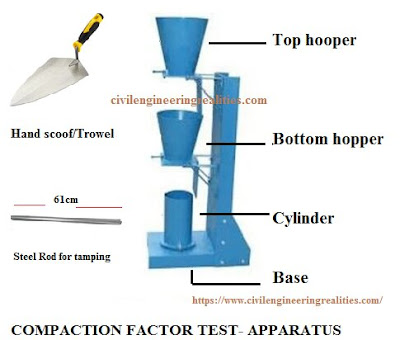The
compaction factor test is used for concrete which have low workability for
which slump test is not suitable.
The compacting factor
test is performed to ascertain the workability of the concrete. The slump test
does not give accurate results for low worability of concrete when slump is<50mm.
The compaction factor
test is a workability test for concrete conducted in the laboratory. It was
developed by the Road Research Laboratory in the United Kingdom and is used to
determine the workability of concrete.
The compaction factor is defined as the ratio of the weight of partially
compacted concrete to the weight of fully compacted concrete.
Compaction factor test Apparatus:-
Compaction factor test apparatus consists of two conical
hoppers and a bottom cylinder which is arranged properly
Steel rod of 1.6cm, diameter with a length of 61cm is is used to level
the concrete.
A weight balance is used to weight the concrete.
Hand
scoop (15.2 cm long) and a balance.

PROCEDURE:
1.Prepare
M15 grade concrete.the mixture with 1: 2: 4 by mixing the required amount of
water according to the water cement ratio and mix the fresh concrete.
2.See
that the inner surface of the conical hopper should be free of moisture and
apply grease to it. Close the trap door of the upper/top hopper.
3.Then
measure the weight of the empty bottom cylinder as W1.
4.Fill
fresh concrete into the upper/top conical hopper without disturbing the sample.
5.After
this, the trap door of an upper hopper is opened. Thus the concrete falls on
the lower/bottom hopper.
6.Wait
for 2-3 seconds and check if the entire concrete has fallen from the top hopper
to the bottom hopper. If not, a slight tamping is done until the entire
concrete falls into the bottom hopper.
7.Now
open the bottom hopper trap door, and the entire concrete has fallen on the
cylinder. Using the trowel, remove excess concrete on the top surface of the
cylinder.
8.Weigh
the cylinder with partially filled concrete as W2.
9.Then
the cylinder is emptied, and the concrete sample is filled again in 3 layers,
each layer being given 25 blows using a steel rod. Now, the concrete inside the
cylinder is completely compacted.
10.Measure
the weight of the cylinder completely with concrete as W3 .
Dimensions of compacting factor test apparatus
ADVANTAGES:
• Compression factor
test gives more information than slump test.
• The test is a dynamic
test and is thus more suitable for concrete mixture static tests.
DISADVANTAGES:
• The large and heavy
nature of the device reduces its usefulness in the field. In addition, the test
method requires an equilibrium to measure the mass of concrete in the cylinder.
• The amount of work
applied to the concrete being tested is a function of friction between the
concrete and the hopper, which probably does not reflect additional conditions.
• The test method does
not use vibration, the main compaction method used in the field.
• This test is commercially
available and is often used.
Calculation
of Compaction Factor Value:
The compaction factor is defined as
the ratio of the weight of partially compacted concrete to the weight of fully
compacted concrete.
Compacting Factor = (weight
of partially compacted concrete) / (weight of fully Concrete Concrete)
= W2 – W1 / W3
- W1
Here,
W1 = Weight of empty
cylinder.
W2 = Weight of partially
compacted concrete.
W3 = weight of fully
Concrete Concrete.
Result of Compaction Factor
Compaction factor of the
concrete =
The Compaction factor
values ranges from 0.7 to 0.95.
Compacting factor with respect to workability



Post a Comment